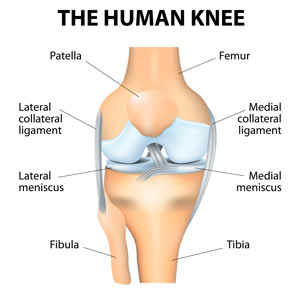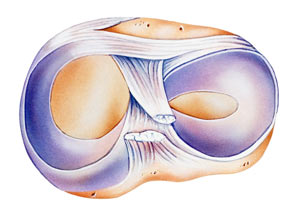 The menisci are two wedge-shaped semilunar discs of fibrocartilaginous tissue. Menisci are functionally a dynamic tissue where they aid in load transmission and distribution, shock absorption, increasing joint congruence and stability, as well as providing lubrication in the joint1 2.
The menisci are two wedge-shaped semilunar discs of fibrocartilaginous tissue. Menisci are functionally a dynamic tissue where they aid in load transmission and distribution, shock absorption, increasing joint congruence and stability, as well as providing lubrication in the joint1 2.
Each knee has two menisci, a medical meniscus and a lateral meniscus. The medial meniscus is located towards the inside of the knee and it has a more distinctive crescent shape than the lateral, which is located on the outside of the knee. Both menisci are attached to the tibia by the meniscotibial ligaments with the medial meniscus also being firmly attached to the medial collateral ligament (the lateral meniscus is not attached to the lateral collateral ligament). This makes the medial meniscus less mobile and more prone to injury compared to the lateral meniscus, especially due to valgus and torsional movements.
 The menisci are able to undergo high degrees of loading based on the arrangement of collagen fibres in dense bundles along a circumferential pattern which prevent radial extrusion. Due to its unique wedge-shape, the menisci have a key role in redistributing compressive loads into tensile forces around its circumference, thus reducing contact stresses in the joint and preserving the articulating surface; this is referred to as the 'hoop stress mechanism'.
The menisci are able to undergo high degrees of loading based on the arrangement of collagen fibres in dense bundles along a circumferential pattern which prevent radial extrusion. Due to its unique wedge-shape, the menisci have a key role in redistributing compressive loads into tensile forces around its circumference, thus reducing contact stresses in the joint and preserving the articulating surface; this is referred to as the 'hoop stress mechanism'.
Based on the circumferential orientation of the collagen bundles, the tissue exhibits anisotropic tensile properties as well as demonstrating different zonal organization radiating from the inside-out. The outer edge of the meniscus is referred to as the red (vascular zone) as this is some level of blood supply through small arteries around the joint. The inner edge of the meniscus is referred to as the white zone, given the poor blood supply. For this reason, it is very difficult for the meniscus to heal following injury.
